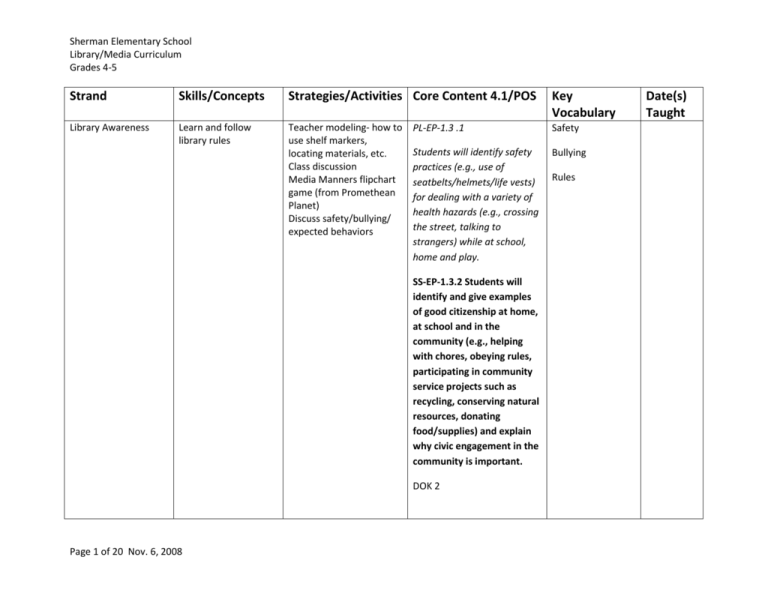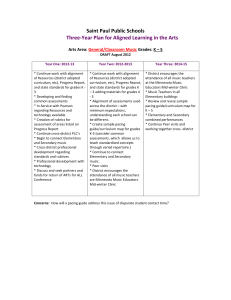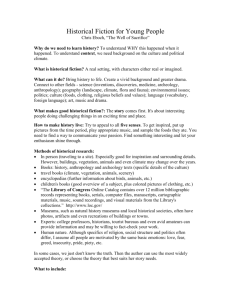EL-4/5-RRT-S-2 - Grant County Schools
advertisement

Sherman Elementary School Library/Media Curriculum Grades 4-5 Strand Skills/Concepts Strategies/Activities Core Content 4.1/POS Key Vocabulary Library Awareness Learn and follow library rules Teacher modeling- how to use shelf markers, locating materials, etc. Class discussion Media Manners flipchart game (from Promethean Planet) Discuss safety/bullying/ expected behaviors PL-EP-1.3 .1 Safety Students will identify safety practices (e.g., use of seatbelts/helmets/life vests) for dealing with a variety of health hazards (e.g., crossing the street, talking to strangers) while at school, home and play. Bullying SS-EP-1.3.2 Students will identify and give examples of good citizenship at home, at school and in the community (e.g., helping with chores, obeying rules, participating in community service projects such as recycling, conserving natural resources, donating food/supplies) and explain why civic engagement in the community is important. DOK 2 Page 1 of 20 Nov. 6, 2008 Rules Date(s) Taught Sherman Elementary School Library/Media Curriculum Grades 4-5 Library Awareness Library Awareness Reading Identify all parts of fiction and nonfiction books Choose fiction and nonfiction materials at appropriate interest and reading levels Read alouds; Magazine selections; Nailing Nonfiction activity; Dot/AR/ Book Adventure FIND CC! Fiction Non fiction RD-04/05-2.0.1 Students will identify and describe the characteristics of fiction, nonfiction, poetry or plays. Fiction Non-fiction Poetry Play Characteristics Scan skim Key information Reading level DOK 2 EL-4/5-DIU-S-4 Students will distinguish between fiction and nonfiction texts EL-4/5-RRT-S-2 Students will self-select texts based on with personal interests RD-04-1.0.7 Students will scan to find key information. RD-04/05-1.0.8 Students will skim to get the general meaning of a passage. Library Awareness Library Awareness Information Literacy Locate fiction, nonfiction, biography, and reference materials in the library Identify the classes of the Dewey Decimal System and locate Page 2 of 20 Nov. 6, 2008 Book Match game Magical Manuscripts: The Dewey Decimal System activity; Dewey Decimal CC? Fiction Non fiction Biography Reference Dewey decimal system Call numbers Sherman Elementary School Library/Media Curriculum Grades 4-5 Library Awareness Library Awareness books using the Dewey Decimal System Use call numbers to locate materials on shelves Recognizes the value and guidance provided by literary awards and reviews Information Literacy/Reading Identify the parts of a book. Information Literacy Identify and use various media forms (i.e., newspaper, Page 3 of 20 Nov. 6, 2008 System flipchart; Dewey PowerPoint Spine label Call numbers Newbery winners, Caldecott winners read alouds/activities; Junior Library Guild; Battle of the Books; Bluegrass Awards book voting project Oral discussions and quizzes Investigating Indexes activity; Castles and Creatures activity; Decisions, Decisions game; Cube and Cards game; Shape Up game Newspaper scavenger hunt; Whatsit, Who and Which activity; Caldecott award Newbery medal RD-EP-5.0.4/5 Students will apply knowledge of text features (e.g., pictures, lists, charts, graphs, tables of contents, indexes, glossaries, captions, headings) to answer questions about a passage. DOK 2 EL-4/5-DIU-S-1 Students will use comprehension strategies Title Author Illustrator Spine Jacket Title page Publisher Copyright Index Glossary Table of Contents Dedication page Captions Graphs Call Numbers Newspaper Magazine Radio Movie Sherman Elementary School Library/Media Curriculum Grades 4-5 radio, magazine, movie, cartoons) Newspapers in Education Use thesaurus, dictionary, atlas, telephone directory, encyclopedia almanac and globe Profound Proverbs activity; Redwall’s Riddles- Choosing the Best Reference Tool activity; Reference Safari activity; Decisions, Decisions game Information Literacy Recognize and use the elements of research to complete contentspecific research Research to the Rescue activity Information literacy Uses databases such as KYVL and library catalog Our Librarian Won’t Tell Us Anything unit; KYVL webquest; Modeling and practice of using Destiny catalog Information Literacy Page 4 of 20 Nov. 6, 2008 (e.g., using prior knowledge, predicting, generating clarifying, literal and inferential questions, constructing sensory images, locating and using text features) while reading, listening to, or viewing literary and informational texts EL-4/5-FF-S-5 Students will use resources (e.g., dictionaries, glossaries, thesauruses) to identify multiple meanings of words, content-specific meanings of words, and precise use of vocabulary Cartoon Sensory images Predicting Clarifying Inference Literary text Informational text Dictionary Glossary Thesaurus T-I-RIPSI-U-1 Students will understand that technology assists in gathering, organizing and evaluating information from a variety of sources to answer essential questions. T-I-RIPSI-S-R1 Task definition Strategies Location Access Synthesis evaluation Students will gather and use accurate information from a variety of electronic sources (e.g. teacher-selected Web sites, CDROM, encyclopedias and automated card catalog, Online card catalog Database KYVL e-encyclopedia Sherman Elementary School Library/Media Curriculum Grades 4-5 Information Literacy Information literacy Information literacy Identify authoritative information on the Internet Uses video and audio information to enhance learning Ethically uses materials Page 5 of 20 Nov. 6, 2008 Wikipedia webquest; Our Librarian Won’t Tell Us Anything unit Our Librarian Won’t Tell Us Anything unit; View video clips from Encyclomedia Our Librarian Won’t Tell Us Anything unit; Plagiarism activity; Class discussion online virtual library; word processing, database, spreadsheet) in all content areas T-I-RIPSI-S-R3 Authoritative Students will evaluate the accuracy, relevance, appropriateness, comprehensiveness and bias of electronic information sources T-I-RIPSI-S-R1 Relevant Students will gather and use accurate information from a variety of electronic sources (e.g. teacher-selected Web sites, CDROM, encyclopedias and automated card catalog, online virtual library; word processing, database, spreadsheet) in all content areas T-I-SESI-S-EI1 Database Students will investigate basic issues related to responsible use of technology and describe personal consequences of inappropriate use (e.g., plagiarism, intellectual property, copyright and the conditions of Acceptable Usage Policy) Plagiarism Accurate Bias KYVL Encyclomedia Ethics Copyright Intellectual property Sherman Elementary School Library/Media Curriculum Grades 4-5 Information literacy Reading Uses standard bibliographical information to cite a source Beastly Bibliography activity; Identify various literary forms Venn Diagram; Class discussion; various read alouds; Book talks; Reading Bingo; T-I-RIPSI-S-R2 Bibliography Students will correctly cite sources Source footnote RD-04/05-2.0.1 Fable Students will identify and describe the characteristics of fiction, nonfiction, poetry or plays. Myth DOK 2 Novel Legend Folktale Poem Short story Reading Identify various genres of fiction Genre matching game; Library scavenger hunt; Genre unit- worksheets; RD-04/05-2.0.1 Adventure Students will identify and describe the characteristics of fiction, nonfiction, poetry or plays. Mystery DOK 2 Science fiction Realistic fiction Historical fiction Fantasy Page 6 of 20 Nov. 6, 2008 Sherman Elementary School Library/Media Curriculum Grades 4-5 Reading Identify author’s purpose and intended audience in a selection Reading response journal, group identification activity[ Class & group discussion, Anticipatory activities, theme overviews, active reading guides, RD-04/05-3.0.3 Author’s purpose Students will identify an author’s purpose in a passage. DOK 2 RD-04/05-5.0.1 Students will evaluate what is read based on the author’s word choice, content or use of literary elements. DOK 3 Reading Alphabetize beyond third letter Shelving challenges; ABC order worksheets EL-4/5-FF-S-5 ????? Students will use resources (e.g., dictionaries, glossaries, thesauruses) to identify multiple meanings of words, content-specific meanings of words, and precise use of vocabulary Reading Interpret stories and relate to personal experiences Add reading bullet related to text-self connections! AH-04/05-4.3.2 Students will improvise to Page 7 of 20 Nov. 6, 2008 Sherman Elementary School Library/Media Curriculum Grades 4-5 Reading Analyze the plot, characters and setting of a selection thoroughly Tra-la-laa! Instant Stories activity; Questioning activities/group discussion; Compare and contrast activities; character analysis graphic organizer; story maps; character profiles/sketches tell stories that show action and have a clear beginning, middle and end. (Literary elements) RD-04/05-2.0.2 Plot Students will identify or explain literary elements (e.g., characterization, setting, plot, theme, point of view) in a passage. Setting DOK 3 Characterization Theme Point of view Mood Conflict (man vs. self, man vs. society, man vs. man, man vs. nature) dialogue Reading Explain theme in selections Page 8 of 20 Nov. 6, 2008 Read alouds; think-pairshare activities; RD-/0505-2.0.2 Theme Students will identify or explain literary elements (e.g., characterization, setting, plot, theme, point of view) in a passage. Main idea DOK 3 Stated Implied Sherman Elementary School Library/Media Curriculum Grades 4-5 Reading Reading Explain simplistic symbolism in a selection Group discussion; Thinkpair-share; American symbols activity (Veteran’s Day, Constitution Day, Election Day); Encyclomedia clips Identify foreshadowing, imagery and figurative language in a reading selection Dire Dilemmas: Foreshadowing and Flashback activity RD-04/05-5.0.2 Imagery Students will identify literary Symbolism devices such as foreshadowing, imagery or figurative language (similes, metaphors, personification, hyperbole). DOK 2 RD-04/05-5.0.2 Students will identify literary devices such as foreshadowing, imagery or figurative language (similes, metaphors, personification, hyperbole). DOK 2 Foreshadowing Figurative language Simile Metaphor Personification Onomatopoeia Hyperbole Alliteration Reading Social Studies Arts and Humanities Identify and discern between folk tales, tall tales and myths Page 9 of 20 Nov. 6, 2008 Read folktales, tall tales and myths. AH-04/05-2.3.1 Folktale Students will identify how drama has been a part of cultures and time periods throughout history. DOK 2 Myth Tall tale Sherman Elementary School Library/Media Curriculum Grades 4-5 Cultures: Native American, Traditional Appalachian West African (The use of storytelling, myths, legends, folktales in these cultures) Legend Culture Periods: Colonial American European influence on American drama/theatre, plays from England (The influence of Europe was very strong in the colonies due to the movement of settlers from Europe to America.) Social Studies Reading Arts and Humanities Identify elements of Native American culture through visual arts, storytelling and music Native American read alouds; Encyclomedia clips Native American includes period in North America before European settlement AH-04/05-2.3.1 Students will identify how drama has been a part of cultures and time periods throughout history. DOK 2 Cultures: Native American, Traditional Appalachian West African (The use of storytelling, myths, legends, folktales in these cultures) Periods: Colonial American - Page 10 of 20 Nov. 6, 2008 Culture Beliefs Traditions Customs Perspective Era Diversity Sherman Elementary School Library/Media Curriculum Grades 4-5 European influence on American drama/theatre, plays from England (The influence of Europe was very strong in the colonies due to the movement of settlers from Europe to America.) Native American includes period in North America before European settlement Prejudice Artifacts Primary/secondary source Interaction Social institution Stereotype Native American Indigenous Social Studies Reading Arts and Humanities Identify elements of colonial culture through visual arts, storytelling and music th (5 Grade) Page 11 of 20 Nov. 6, 2008 Everyday Life in Colonial Times activity; Encyclomedia clips; Read alouds AH-04/05-2.3.1 Culture Students will identify how drama has been a part of cultures and time periods throughout history. DOK 2 Cultures: Native American, Traditional Appalachian West African (The use of storytelling, myths, legends, folktales in these cultures) Beliefs Periods: Colonial American - Prejudice Traditions Customs Perspective Era Diversity Sherman Elementary School Library/Media Curriculum Grades 4-5 European influence on American drama/theatre, plays from England (The influence of Europe was very strong in the colonies due to the movement of settlers from Europe to America.) Native American includes period in North America before European settlement Artifacts Primary/secondary source Interaction Social institution Stereotype Native American Indigenous Colonists Immigrant Democratic Principles Social Studies Reading Arts and Humanities Identify elements of Kentucky’s culture (Appalachian) through visual arts, storytelling and music (4th Grade) Page 12 of 20 Nov. 6, 2008 Read alouds by Kentucky authors; “Where I’m From” poetry/ George Ella Lyons; Jesse Stuart author spotlight; Encyclomedia clips AH-04/05-2.3.1 Culture Students will identify how drama has been a part of cultures and time periods throughout history. DOK 2 Cultures: Native American, Traditional Appalachian West African Beliefs Traditions Customs Appalachian Sherman Elementary School Library/Media Curriculum Grades 4-5 (The use of storytelling, myths, legends, folktales in these cultures) Periods: Colonial American European influence on American drama/theatre, plays from England (The influence of Europe was very strong in the colonies due to the movement of settlers from Europe to America.) Native American includes period in North America before European settlement Artifacts Primary/secondary sources Stereotype Values Natural resources Economy Oral traditions Ancestors Poverty Social Studies Reading Information Literacy Identify primary and secondary sources in historical documents Detailed Diaries activity SS-04/05-5.1.1 Primary source Students will use a variety of primary and secondary sources (e.g., artifacts, diaries, maps, timelines) to describe significant events in the history of the U.S. and interpret different perspectives. Secondary source DOK 3 Page 13 of 20 Nov. 6, 2008 Diary Map Timeline Artifacts Photographs Sherman Elementary School Library/Media Curriculum Grades 4-5 Journals Autobiographies Biographies Speeches Records Arts and Humanities Dramatize various literary works Readers’ theater; Play read alouds; Drama vocabulary games AH-04/05-3.3.1 Students will identify how drama/theatre fulfills a variety of purposes. DOK 2 Purposes of drama/theatre: (different roles of drama) Sharing the human experience - to express or communicate emotion, feelings, ideas, information through dramatic works (e.g., storytelling, role playing, narrative works) Passing on tradition and culture - to express or communicate feelings, ideas, information (e.g., narrative, storytelling, folktales, myths and legends) Recreational drama for entertainment (e.g., drama/theatre as a hobby) Page 14 of 20 Nov. 6, 2008 character costumes lighting plot props scenery expression character movement pantomime Sherman Elementary School Library/Media Curriculum Grades 4-5 Artistic expression - drama created with the intent to express or communicate emotion, feelings, ideas, information (e.g., dramatic works created and performed by actors in a theatrical setting for an audience) AH-04/05-4.3.1 Students will create and perform using elements of drama (Literary, Technical, Performance) AH-04/05-4.3.2 Students will improvise to tell stories that show action and have a clear beginning, middle and end. (Literary elements) Technology Information Literacy Use Internet resources appropriate for assigned task Our Librarian Won’t Tell Us Anything activities /project Technology Speaking, Listening and Observing Make a presentation using both print and electronic resources Our Librarian Won’t Tell Us Anything unit Page 15 of 20 Nov. 6, 2008 TE-SK-I-ICP-3c Students will use technology to collect data for content area assignments/projects T-I-ICP-S-C4 Internet Students will use a variety of tools and formats (oral presentations, journals and multimedia presentations) to summarize and communicate the results of observations and investigations Word PowerPoint Presentation Summary Sherman Elementary School Library/Media Curriculum Grades 4-5 Technology Technology Logs on to network with individual login and password Properly cares for computer equipment Modeling and practice Teacher modeling, student practice T-I-ICP-S-I4 User name Students will explain the use of networks and the need for login procedures (e.g., stand alone, network, file server, LANs network resources Password T-I-ICP-U-2 CPU Students will understand that technology requires proper care and maintenance to be used effectively. Monitor Network Internet Keyboard Mouse laptop Technology Uses appropriate technology terminology Technology bingo game; T-I-ICP-S-I1 CPU Students will investigate different technology devices and systems (e.g., computer processor unit, monitor, keyboard, disk drive, printer, mouse, digital cameras, interactive white boards) CD DVD Monitor Printer Mouse Activboard keyboard Technology Uses word processing program create and Page 16 of 20 Nov. 6, 2008 Our Librarian Won’t Tell Us Anything unit T-I-RIPSI-S-R1 Microsoft Word Sherman Elementary School Library/Media Curriculum Grades 4-5 modify documents Students will gather and use accurate information from a variety of electronic sources (e.g. teacher-selected Web sites, CDROM, encyclopedias and automated card catalog, online virtual library; word processing, database, spreadsheet) in all content areas Font Clip art Internet Spell Check Bold Italics Underline Page layout Cut/copy/paste Header/footer Technology Uses multimedia tools (i.e., PowerPoint) effectively by choosing appropriate layout and format (4th grade); applies transitions, animations and timings (5th grade) Our Librarian Won’t Tell Us Anything unit T-I-ICP-S-P1 Students will develop, publish and present information in print and digital formats PowerPoint Presentation Word Art Background Slide Show Font Clip Art Format Transition animation Technology Makes presentation using multimedia tools Page 17 of 20 Nov. 6, 2008 Our Librarian Won’t Tell Us Anything unit T-I-ICP-S-P1 Students will develop, publish PowerPoint Presentation Word Art Sherman Elementary School Library/Media Curriculum Grades 4-5 and present information in print and digital formats Background Slide Show Font Clip Art Format Transition animation Technology Uses keywords to conduct an Internet search Our Librarian Won’t Tell Us Anything unit Technology Understands the Acceptable Use Policy Class discussion Technology Uses safety skills when using technology Page 18 of 20 Nov. 6, 2008 Our Librarian Won’t Tell Us Anything unit; Class discussion; ISafe activities Keyword Google Search Engine Internet Authoritative Internet safety T-I-SESI-S-EI1 Internet safety Students will investigate basic issues related to responsible use of technology and describe personal consequences of inappropriate use (e.g., plagiarism, intellectual property, copyright and the conditions of Acceptable Usage Policy) T-I-SESI-S-S1 Plagiarism Students will explain the importance of safe Internet use (e.g., iSafe skills) Personal information Intellectual property copyright Chat Sherman Elementary School Library/Media Curriculum Grades 4-5 T-I-SESI-S-S2 email Students will apply safe behavior when using technology T-I-SESI-S-EI2 Students will explore, investigate and practice the use of technology in an appropriate, safe and responsible manner Technology Uses student email to communicate with teachers and fellow students Modeling email use; Discussion of appropriate use of email T-I-ICP-S-C5 Students will use online collaborative tools (e.g., email, videoconferencing) Email Attachment Reply Forward Delete Inbox Technology Uses document camera Modeling and supervised practice T-I-ICP-S-C1 Document camera Activboard Uses pen drive to retrieve and save information Our Librarian Won’t Tell Us Anything unit Students will use technology to communicate in a variety of modes (e.g., audio, speech to text, print, media) T-I-ICP-S-I1 Students will investigate different technology devices and systems (e.g., computer processor unit, monitor, keyboard, disk drive, printer, mouse, digital cameras, Removable drive Technology Page 19 of 20 Nov. 6, 2008 Pen drive USB Sherman Elementary School Library/Media Curriculum Grades 4-5 Technology Recognizes when, whom and how to ask for technical assistance Page 20 of 20 Nov. 6, 2008 Our Librarian Won’t Tell Us Anything unit; Practice throughout the year interactive white boards) T-I-RIPSI-S-IPS1 Students will determine which technology is useful and select the appropriate tool(s) (e.g., calculators, data collection probes, videos, educational software) to inquire/problem- solve in selfdirected and extended learning Troubleshooting Help button Software Hardware Shut down Log off




